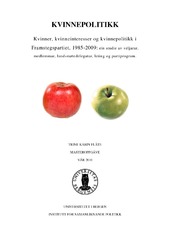| dc.description.abstract | This thesis is about women politics in the Norwegian Progress Party (Framstegspartiet, FrP) from 1985 to 2009. Many have studied women politics, women friendly politics, women interests and women representation before, but few have studied this in populist radical right parties. This party family is known to focus more on the difference of the sexes and their equal value, and less on the equality of the sexes through equal participation or representation, which makes it interesting to explain the women politics in their party programs and look into if women's participation as voters, members and in the party organization (delegates to the national convention, central board and chairman) are related to the level of women politics. To be able to relate women and women politics it is necessary to know something about women's interests. Women interests wary according to ideology which also is related to the voters, members and delegates backgrounds, education, whether you work in the public sector or not and income. I describe the women's interests and backgrounds in FrP and compare them to two close political parties in the political sphere, The Liberals (Høgre) and The Christian Democrats (KrF). I also take a closer look at the voters', members' and delegates' background because one could only expect change if women represent other interests, views or life experiences. This is also of importance because these people are the ones who may affect the politics of the FrP since these are the people who shape and adopt the program, or simply the party's target group. The theoretical background is based on Hanna Pitkin (1967) seminal work and her categories of representation. This connects women and their interests and backgrounds to political representation in party and government. The central theories of her work is that women participation in FrP is sometimes related to the level of women policies, although it may also depend on several other factors. Therefore I cannot discard the hypothesis of no relation between women rates in the electorate and in the party organization. There are also relations between the subjective and the objective definitions, but it does not look like FrP will break down the gender role of men as breadwinners and women as caretakers. | en_US |
